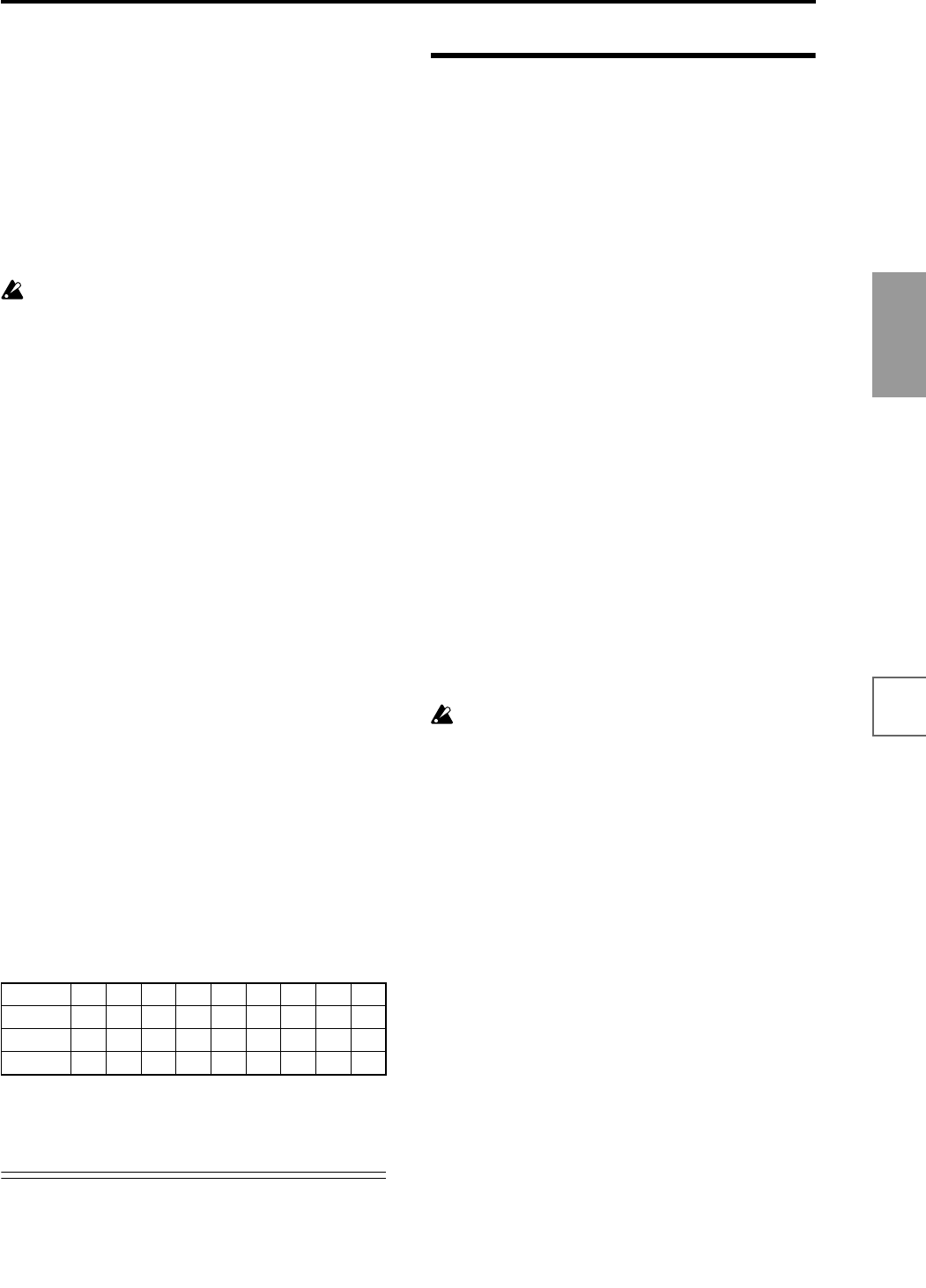
97
Basic functions
Saving dataLoading dataProgram
settings
Combination
settings
Producing
songs
Sampling
settings
Creating a
CD
SMF
playback
System
settings
Drum kit
settings
Arpeggiator
settings
Effects
settings
Other
functions
Depending on the combination settings, it may also
be necessary to change the track settings as well.
In the screens shown above, combination INT-C005: “In
the Pocket” has been copied using “Copy From Combi.”
As described in steps 1 and 2 of the procedure given
earlier, try actually copying this to see for yourself. For the
arpeggiator settings of this combination, refer to p.130.
Taking this setting as an example, determine whether cor-
rection is necessary, and if necessary, what needs to be cor-
rected.
“Arpeggiator Run” A and B are checked, and “MIDI
Channel” 01 and 02 are selected. Corrections must be
made. Correction is necessary for one of the arpeggiators.
If you perform multi-track recording with these settings,
the MIDI channels of T01, 02, 03, 04, 05, and 06 are the
same, so the low-register bass (T01 and T02), the high-reg-
ister synth brass/pad (T03, T04 and T06), and the synth
mallet played by arpeggiator B (T05) will have their per-
formance data combined into one stream, and the perfor-
mance will not be reproduced at playback. (T08 is a
dummy track used to trigger arpeggiator A.)
1 So that the synth mallet played by arpeggiator B can
be recorded separately, change the MIDI channel of
T05.
Select the Sequencer P2: Trk Param, MIDI Ch T01–08
page, and change the T05 “MIDI Channel” to 03.
2 Add settings for triggering arpeggiator B.
Select the Sequencer P2: Trk Param, MIDI Ch T09–10
page, and for track 9 (or any unused track), turn “Sta-
tus” Off, and set the “MIDI Channel” to 01.
(T09 will be a dummy track used to trigger arpeggiator
B.)
3 Select the Sequencer P7: Arpeggiator, Setup T09–16
page. Set the track 9 Assign to B.
This will produce the following settings.
This completes the corrections. In the Sequencer P0:
Play/REC, Preference page, set “Track Select” to any
track whose MIDI channel is 01. Check the “Multi
REC” check box and perform multi-track recording.
Caution and other functions in
Sequencer mode
TRITON STUDIO song data and its compati-
bility
The following two types of song data can be loaded from
Media into TRITON STUDIO’s sequencer.
• Song data saved in TRITON STUDIO’s own format
This data is only for this instrument.
However, it is partially compatible with the TRITON/
TRITONpro/TRITONproX/TRITON-Rack (Multi)
(☞PG p.279). It cannot be loaded into other instru-
ments.
Since the performance will be faithfully reproduced,
including detailed settings of this instrument, you
should use this format to save song data that is
intended for playback on this instrument.
• Standard MIDI Files
This format is not able to provide a totally faithful
reproduction of the performance on TRITON STUDIO
in the way that TRITON STUDIO’s own format does
(although there will be no problem for normal play-
back), but does provide compatibility with other SMF-
compatible devices.
To load or save song data etc., use Disk mode. (☞p.59,
63, PG p.155)
The Compare function
When you perform realtime recording, step recording, or
track editing, this function allows you to make before-
and-after comparisons.
If you continue editing when the [COMPARE] key is
lit, the key will go dark. This now becomes the musi-
cal data that will be selected when the [COMPARE]
key is dark.
Operations for which Compare is available
• Recording to a track
• Track Edit
All commands except for the Utility menu commands
“Memory Status” and “Rename Track” of the
Sequencer P5: Track Edit page.
• Recording to a pattern
• Pattern Edit
All commands except for the page menu commands
“Memory Status,” “Rename Pattern,” “FF/REW
Speed,” and “Rename Track” of the Pattern/Sequencer
P6: RPPR, Pattern Edit page.
• Song Edit
Sequencer P0–P4 and P7–P9 pages: Page menu com-
mands “Delete Song” and “Copy From Song”
Sequencer P1: Cue List page: Page menu commands
“Convert to Song” and “Copy Song”
In general, track and pattern event data can not be
returned to its original state.
Comparing song parameters is possible only during song
editing (when executing a page menu command).
*1. If the “MIDI Channel” of multiple tracks operated by
the arpeggiator is set only to 01, refer to the lines for
“01 only.” If the “MIDI Channel” settings are 01 and
one other channel, such as 01 and 02, or 01 and 03,
then refer to the lines for “01 02, 01 03 etc.” If the
“MIDI Channel” settings are 01 and multiple other
MIDI channels, such as 01 and 02 and 03, then refer to
the line for “01 02 03, etc.”
*2. Correction is necessary only if the tracks operated by
a single arpeggiator are using only “MIDI Channel”
01. In some cases, correction may also be necessary if
the two arpeggiators use the same MIDI channel.
Track T01 T02 T03 T04 T05 T06 T07 T08 T09
Assign Off Off Off Off B Off A A B
Status INT INT INT INT INT INT INT Off Off
MIDI Ch. 01 01 01 01 03 01 02 01 01


















